Analysis of Financial Markets and Institutes Performance
VerifiedAdded on 2021/06/15
|7
|684
|34
Report
AI Summary
This report provides a comprehensive financial analysis of a company, evaluating its performance through various financial ratios. The analysis covers profitability ratios (gross profit margin, net profit margin), liquidity ratios (current ratio, liquid ratio), efficiency ratios (account receivable turnover, inventory turnover), and solvency ratios (debt-equity ratio, debt ratio). The report includes calculations of par value per share and market value per share, along with key ratio comparisons over a five-year period. The analysis highlights the company's trends in financial health and compares its performance with industry standards, offering insights into its strengths and weaknesses. The report utilizes data from 2013 to 2017 and provides a detailed assessment of the company's financial standing and market position.
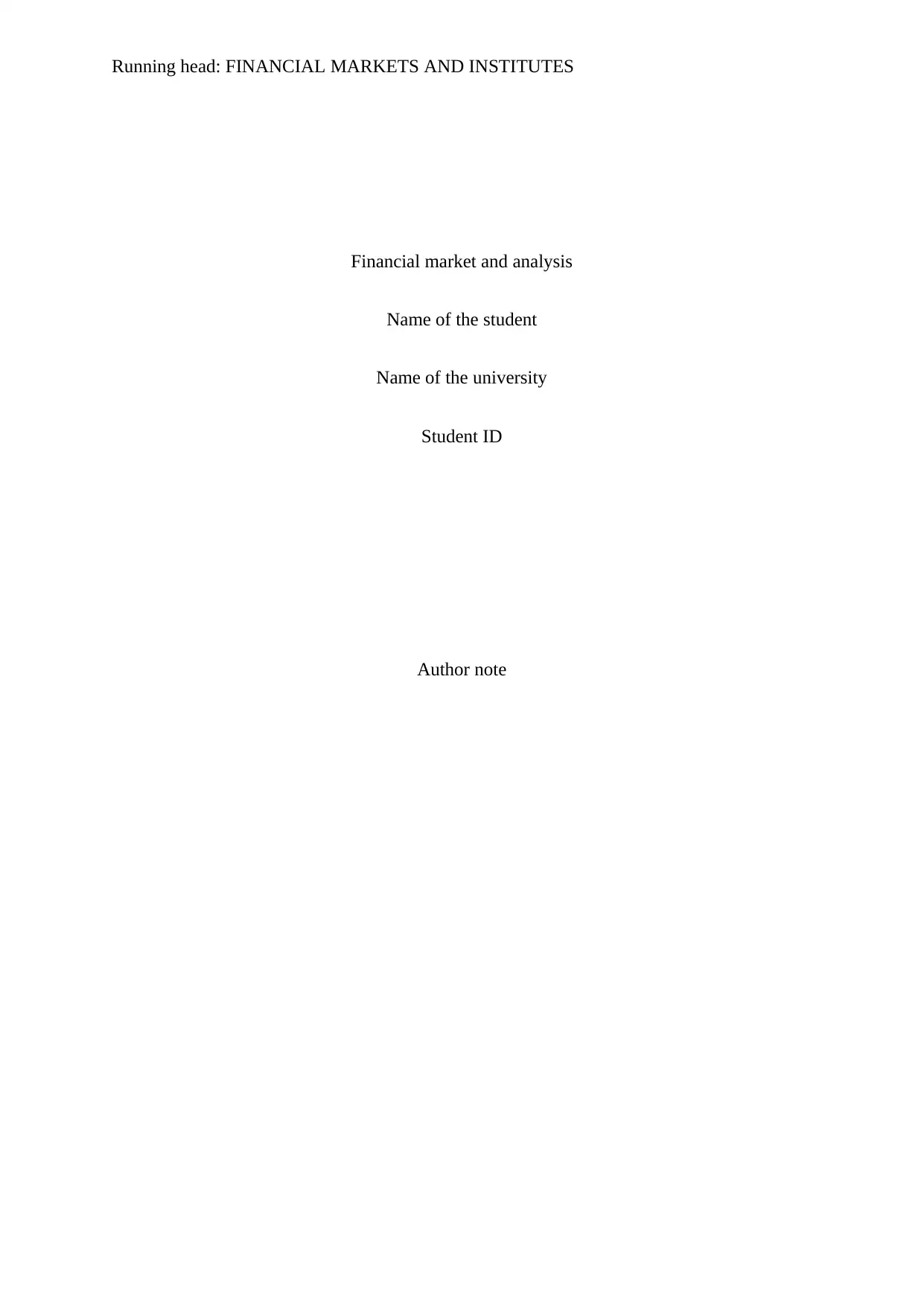
Running head: FINANCIAL MARKETS AND INSTITUTES
Financial market and analysis
Name of the student
Name of the university
Student ID
Author note
Financial market and analysis
Name of the student
Name of the university
Student ID
Author note
Paraphrase This Document
Need a fresh take? Get an instant paraphrase of this document with our AI Paraphraser
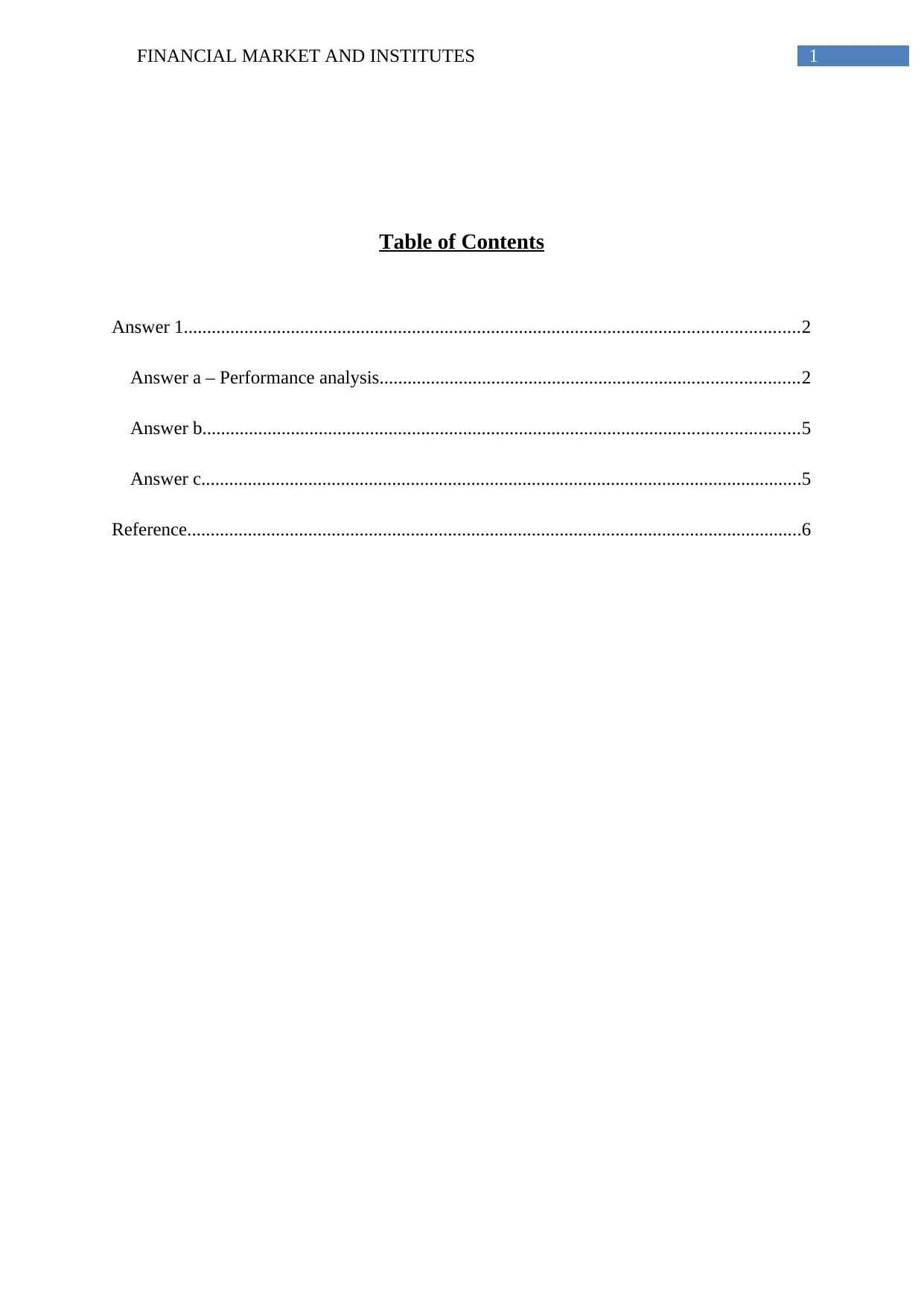
1FINANCIAL MARKET AND INSTITUTES
Table of Contents
Answer 1....................................................................................................................................2
Answer a – Performance analysis..........................................................................................2
Answer b................................................................................................................................5
Answer c.................................................................................................................................5
Reference....................................................................................................................................6
Table of Contents
Answer 1....................................................................................................................................2
Answer a – Performance analysis..........................................................................................2
Answer b................................................................................................................................5
Answer c.................................................................................................................................5
Reference....................................................................................................................................6
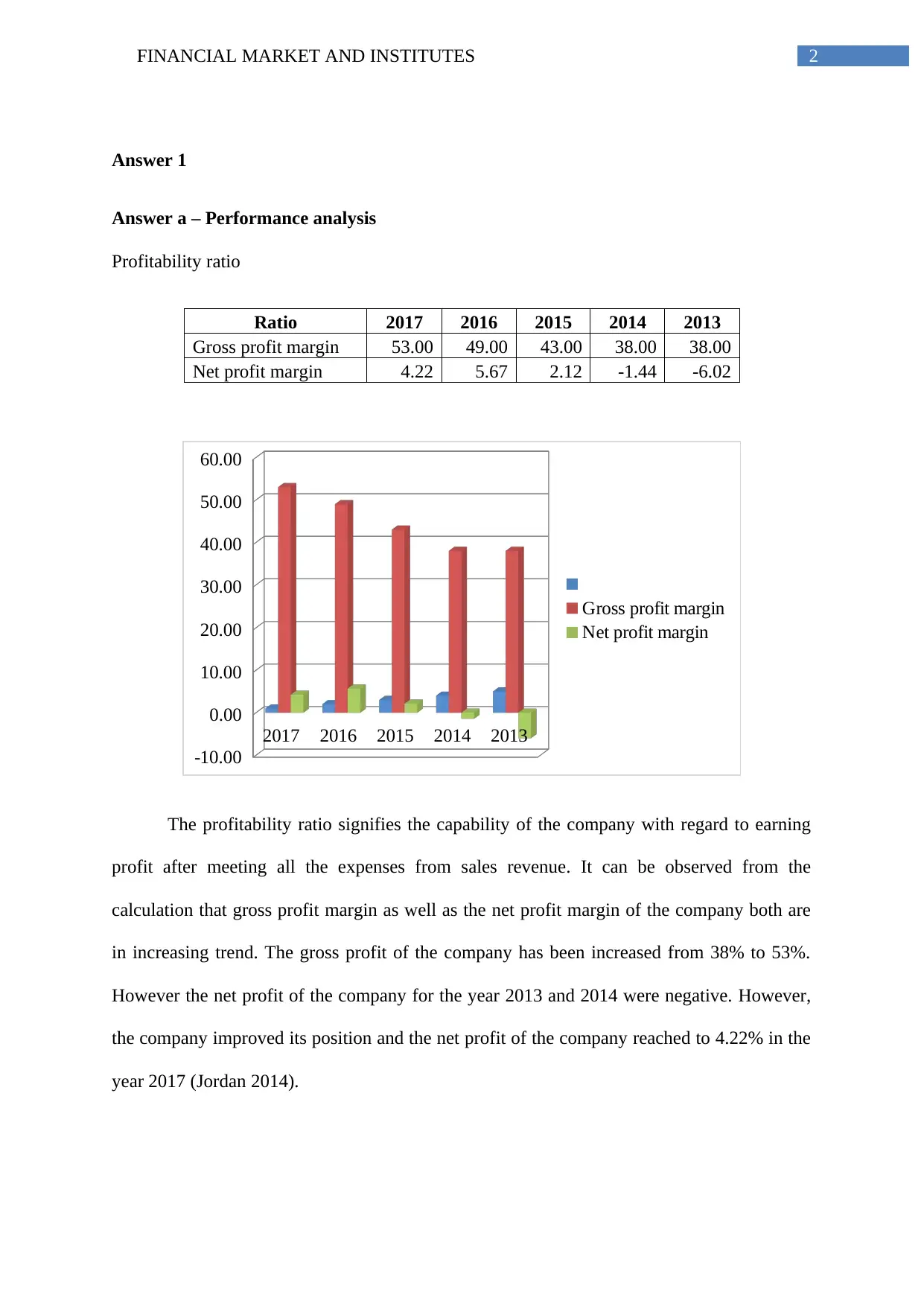
2FINANCIAL MARKET AND INSTITUTES
Answer 1
Answer a – Performance analysis
Profitability ratio
Ratio 2017 2016 2015 2014 2013
Gross profit margin 53.00 49.00 43.00 38.00 38.00
Net profit margin 4.22 5.67 2.12 -1.44 -6.02
2017 2016 2015 2014 2013
-10.00
0.00
10.00
20.00
30.00
40.00
50.00
60.00
Gross profit margin
Net profit margin
The profitability ratio signifies the capability of the company with regard to earning
profit after meeting all the expenses from sales revenue. It can be observed from the
calculation that gross profit margin as well as the net profit margin of the company both are
in increasing trend. The gross profit of the company has been increased from 38% to 53%.
However the net profit of the company for the year 2013 and 2014 were negative. However,
the company improved its position and the net profit of the company reached to 4.22% in the
year 2017 (Jordan 2014).
Answer 1
Answer a – Performance analysis
Profitability ratio
Ratio 2017 2016 2015 2014 2013
Gross profit margin 53.00 49.00 43.00 38.00 38.00
Net profit margin 4.22 5.67 2.12 -1.44 -6.02
2017 2016 2015 2014 2013
-10.00
0.00
10.00
20.00
30.00
40.00
50.00
60.00
Gross profit margin
Net profit margin
The profitability ratio signifies the capability of the company with regard to earning
profit after meeting all the expenses from sales revenue. It can be observed from the
calculation that gross profit margin as well as the net profit margin of the company both are
in increasing trend. The gross profit of the company has been increased from 38% to 53%.
However the net profit of the company for the year 2013 and 2014 were negative. However,
the company improved its position and the net profit of the company reached to 4.22% in the
year 2017 (Jordan 2014).
⊘ This is a preview!⊘
Do you want full access?
Subscribe today to unlock all pages.

Trusted by 1+ million students worldwide
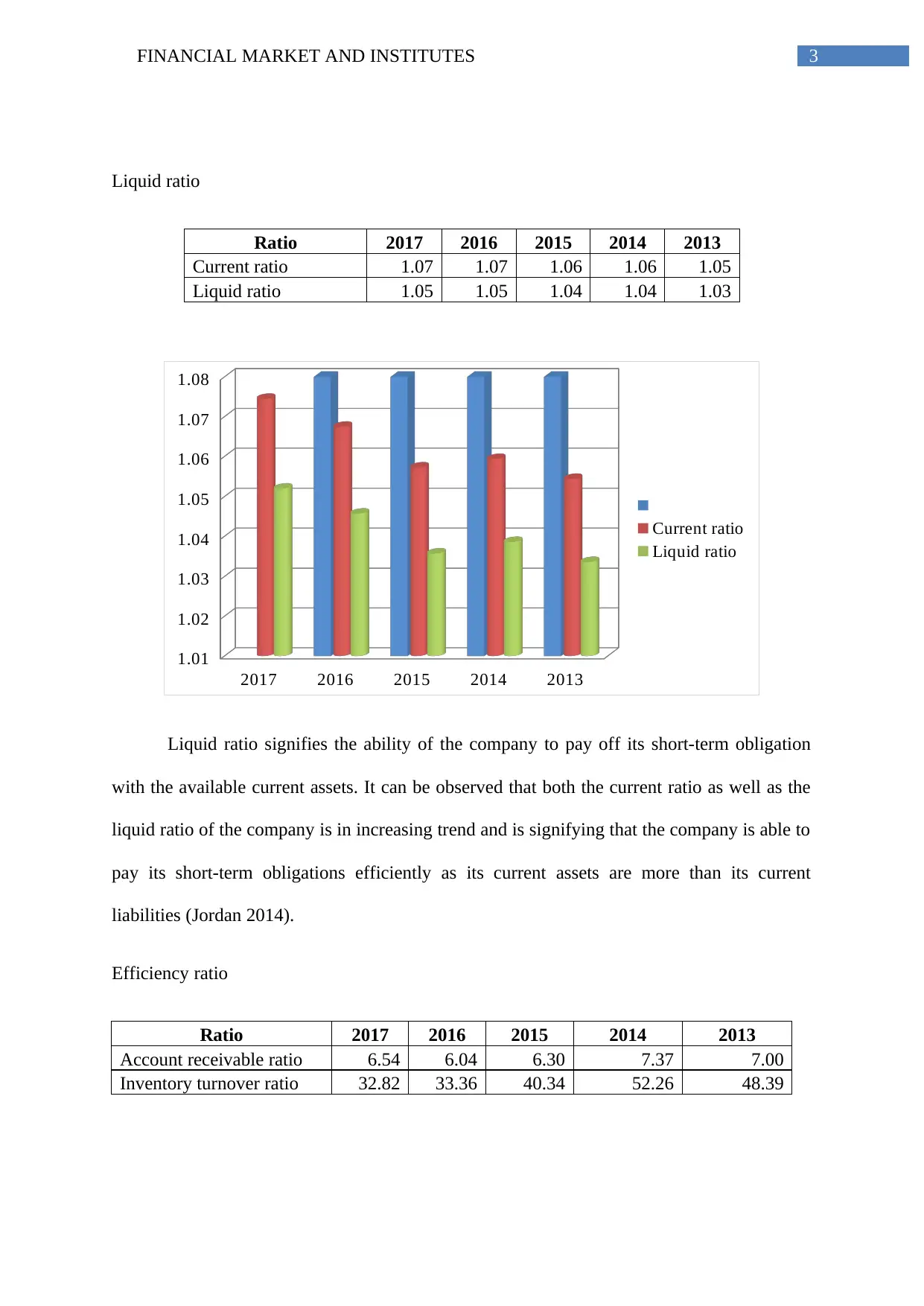
3FINANCIAL MARKET AND INSTITUTES
Liquid ratio
Ratio 2017 2016 2015 2014 2013
Current ratio 1.07 1.07 1.06 1.06 1.05
Liquid ratio 1.05 1.05 1.04 1.04 1.03
2017 2016 2015 2014 2013
1.01
1.02
1.03
1.04
1.05
1.06
1.07
1.08
Current ratio
Liquid ratio
Liquid ratio signifies the ability of the company to pay off its short-term obligation
with the available current assets. It can be observed that both the current ratio as well as the
liquid ratio of the company is in increasing trend and is signifying that the company is able to
pay its short-term obligations efficiently as its current assets are more than its current
liabilities (Jordan 2014).
Efficiency ratio
Ratio 2017 2016 2015 2014 2013
Account receivable ratio 6.54 6.04 6.30 7.37 7.00
Inventory turnover ratio 32.82 33.36 40.34 52.26 48.39
Liquid ratio
Ratio 2017 2016 2015 2014 2013
Current ratio 1.07 1.07 1.06 1.06 1.05
Liquid ratio 1.05 1.05 1.04 1.04 1.03
2017 2016 2015 2014 2013
1.01
1.02
1.03
1.04
1.05
1.06
1.07
1.08
Current ratio
Liquid ratio
Liquid ratio signifies the ability of the company to pay off its short-term obligation
with the available current assets. It can be observed that both the current ratio as well as the
liquid ratio of the company is in increasing trend and is signifying that the company is able to
pay its short-term obligations efficiently as its current assets are more than its current
liabilities (Jordan 2014).
Efficiency ratio
Ratio 2017 2016 2015 2014 2013
Account receivable ratio 6.54 6.04 6.30 7.37 7.00
Inventory turnover ratio 32.82 33.36 40.34 52.26 48.39
Paraphrase This Document
Need a fresh take? Get an instant paraphrase of this document with our AI Paraphraser
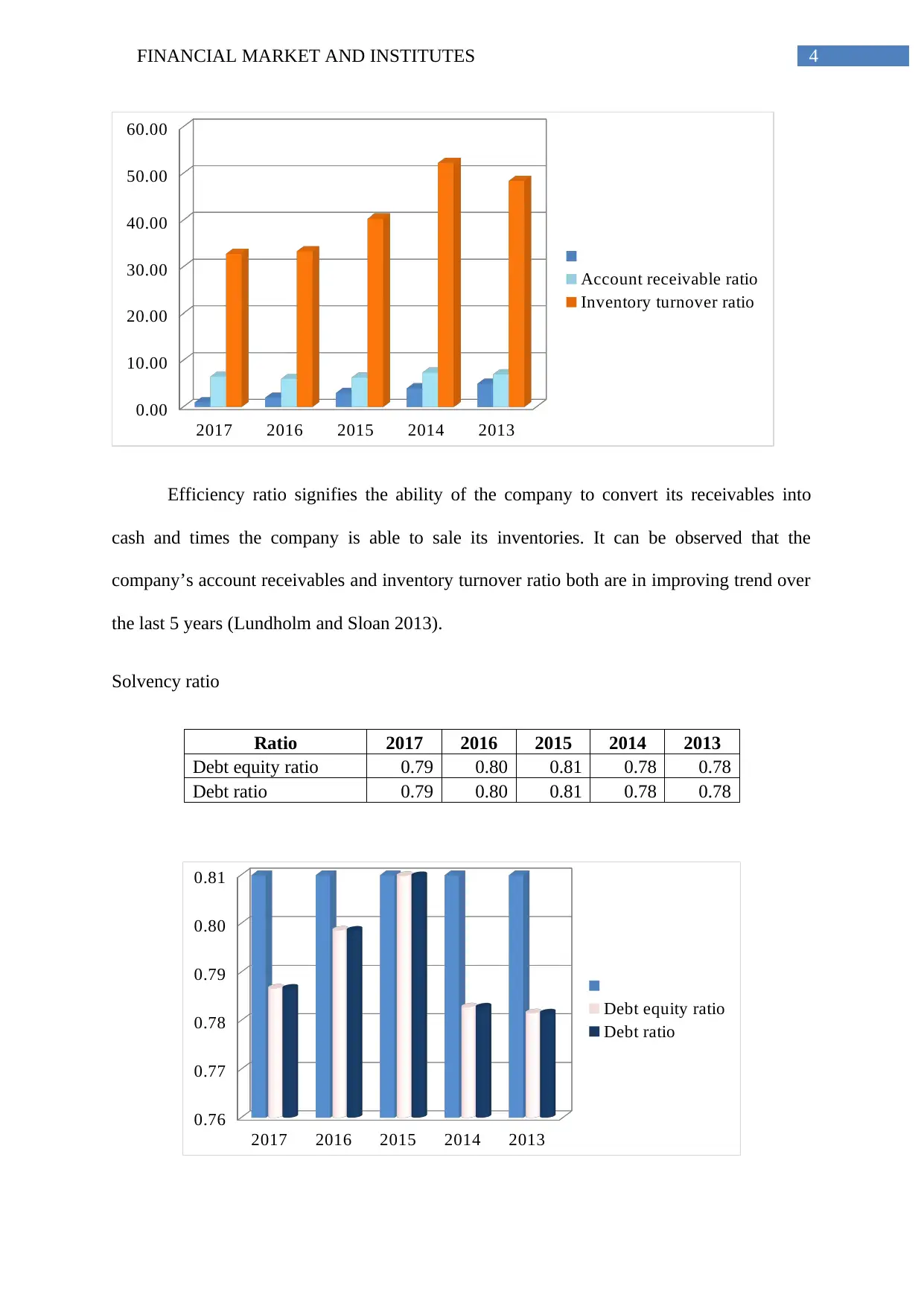
4FINANCIAL MARKET AND INSTITUTES
2017 2016 2015 2014 2013
0.00
10.00
20.00
30.00
40.00
50.00
60.00
Account receivable ratio
Inventory turnover ratio
Efficiency ratio signifies the ability of the company to convert its receivables into
cash and times the company is able to sale its inventories. It can be observed that the
company’s account receivables and inventory turnover ratio both are in improving trend over
the last 5 years (Lundholm and Sloan 2013).
Solvency ratio
Ratio 2017 2016 2015 2014 2013
Debt equity ratio 0.79 0.80 0.81 0.78 0.78
Debt ratio 0.79 0.80 0.81 0.78 0.78
2017 2016 2015 2014 2013
0.76
0.77
0.78
0.79
0.80
0.81
Debt equity ratio
Debt ratio
2017 2016 2015 2014 2013
0.00
10.00
20.00
30.00
40.00
50.00
60.00
Account receivable ratio
Inventory turnover ratio
Efficiency ratio signifies the ability of the company to convert its receivables into
cash and times the company is able to sale its inventories. It can be observed that the
company’s account receivables and inventory turnover ratio both are in improving trend over
the last 5 years (Lundholm and Sloan 2013).
Solvency ratio
Ratio 2017 2016 2015 2014 2013
Debt equity ratio 0.79 0.80 0.81 0.78 0.78
Debt ratio 0.79 0.80 0.81 0.78 0.78
2017 2016 2015 2014 2013
0.76
0.77
0.78
0.79
0.80
0.81
Debt equity ratio
Debt ratio
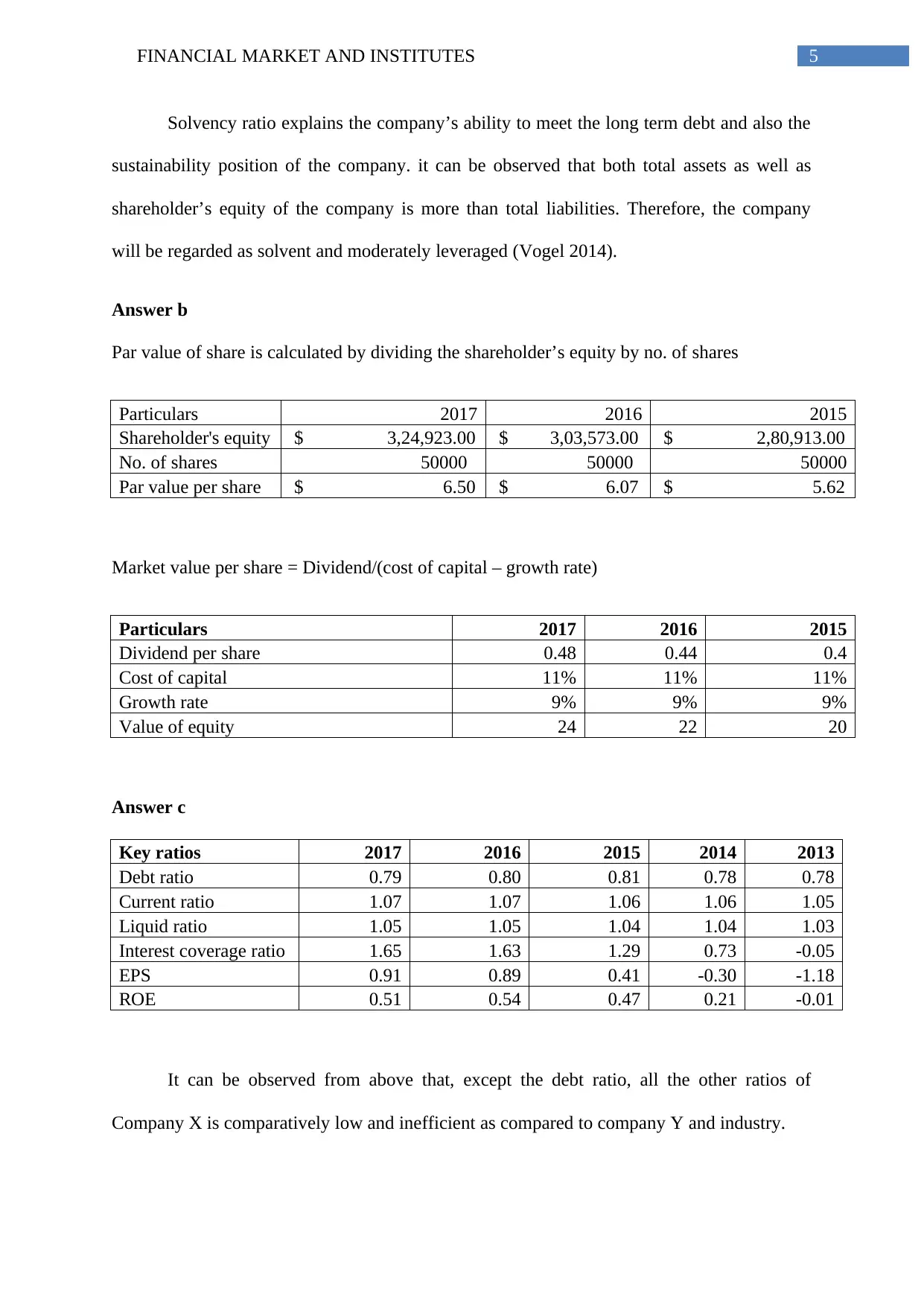
5FINANCIAL MARKET AND INSTITUTES
Solvency ratio explains the company’s ability to meet the long term debt and also the
sustainability position of the company. it can be observed that both total assets as well as
shareholder’s equity of the company is more than total liabilities. Therefore, the company
will be regarded as solvent and moderately leveraged (Vogel 2014).
Answer b
Par value of share is calculated by dividing the shareholder’s equity by no. of shares
Particulars 2017 2016 2015
Shareholder's equity $ 3,24,923.00 $ 3,03,573.00 $ 2,80,913.00
No. of shares 50000 50000 50000
Par value per share $ 6.50 $ 6.07 $ 5.62
Market value per share = Dividend/(cost of capital – growth rate)
Particulars 2017 2016 2015
Dividend per share 0.48 0.44 0.4
Cost of capital 11% 11% 11%
Growth rate 9% 9% 9%
Value of equity 24 22 20
Answer c
Key ratios 2017 2016 2015 2014 2013
Debt ratio 0.79 0.80 0.81 0.78 0.78
Current ratio 1.07 1.07 1.06 1.06 1.05
Liquid ratio 1.05 1.05 1.04 1.04 1.03
Interest coverage ratio 1.65 1.63 1.29 0.73 -0.05
EPS 0.91 0.89 0.41 -0.30 -1.18
ROE 0.51 0.54 0.47 0.21 -0.01
It can be observed from above that, except the debt ratio, all the other ratios of
Company X is comparatively low and inefficient as compared to company Y and industry.
Solvency ratio explains the company’s ability to meet the long term debt and also the
sustainability position of the company. it can be observed that both total assets as well as
shareholder’s equity of the company is more than total liabilities. Therefore, the company
will be regarded as solvent and moderately leveraged (Vogel 2014).
Answer b
Par value of share is calculated by dividing the shareholder’s equity by no. of shares
Particulars 2017 2016 2015
Shareholder's equity $ 3,24,923.00 $ 3,03,573.00 $ 2,80,913.00
No. of shares 50000 50000 50000
Par value per share $ 6.50 $ 6.07 $ 5.62
Market value per share = Dividend/(cost of capital – growth rate)
Particulars 2017 2016 2015
Dividend per share 0.48 0.44 0.4
Cost of capital 11% 11% 11%
Growth rate 9% 9% 9%
Value of equity 24 22 20
Answer c
Key ratios 2017 2016 2015 2014 2013
Debt ratio 0.79 0.80 0.81 0.78 0.78
Current ratio 1.07 1.07 1.06 1.06 1.05
Liquid ratio 1.05 1.05 1.04 1.04 1.03
Interest coverage ratio 1.65 1.63 1.29 0.73 -0.05
EPS 0.91 0.89 0.41 -0.30 -1.18
ROE 0.51 0.54 0.47 0.21 -0.01
It can be observed from above that, except the debt ratio, all the other ratios of
Company X is comparatively low and inefficient as compared to company Y and industry.
⊘ This is a preview!⊘
Do you want full access?
Subscribe today to unlock all pages.

Trusted by 1+ million students worldwide
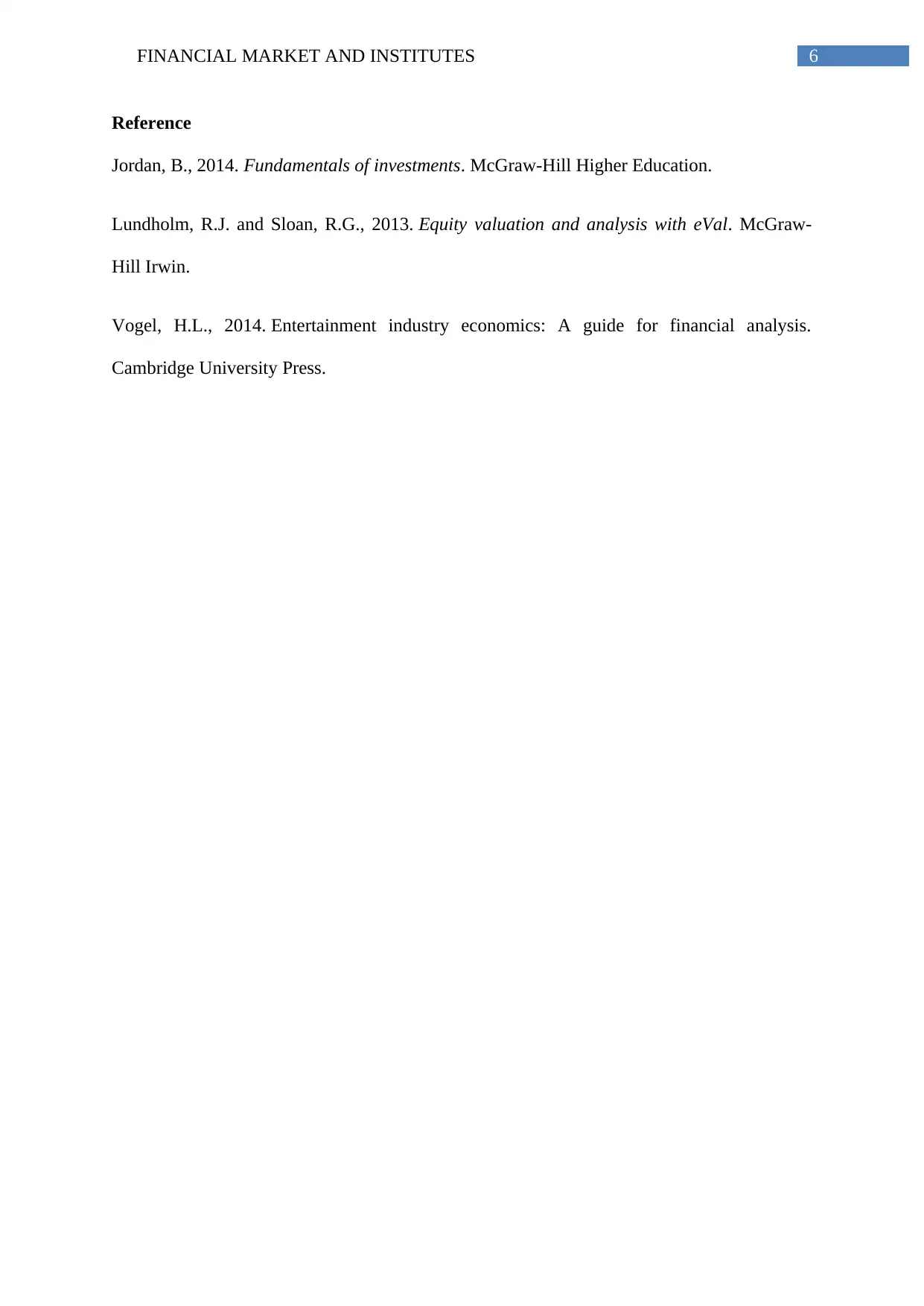
6FINANCIAL MARKET AND INSTITUTES
Reference
Jordan, B., 2014. Fundamentals of investments. McGraw-Hill Higher Education.
Lundholm, R.J. and Sloan, R.G., 2013. Equity valuation and analysis with eVal. McGraw-
Hill Irwin.
Vogel, H.L., 2014. Entertainment industry economics: A guide for financial analysis.
Cambridge University Press.
Reference
Jordan, B., 2014. Fundamentals of investments. McGraw-Hill Higher Education.
Lundholm, R.J. and Sloan, R.G., 2013. Equity valuation and analysis with eVal. McGraw-
Hill Irwin.
Vogel, H.L., 2014. Entertainment industry economics: A guide for financial analysis.
Cambridge University Press.
1 out of 7
Related Documents
Your All-in-One AI-Powered Toolkit for Academic Success.
+13062052269
info@desklib.com
Available 24*7 on WhatsApp / Email
![[object Object]](/_next/static/media/star-bottom.7253800d.svg)
Unlock your academic potential
Copyright © 2020–2026 A2Z Services. All Rights Reserved. Developed and managed by ZUCOL.





